A Brand’s Guide to the Most Popular Global Messaging Channels
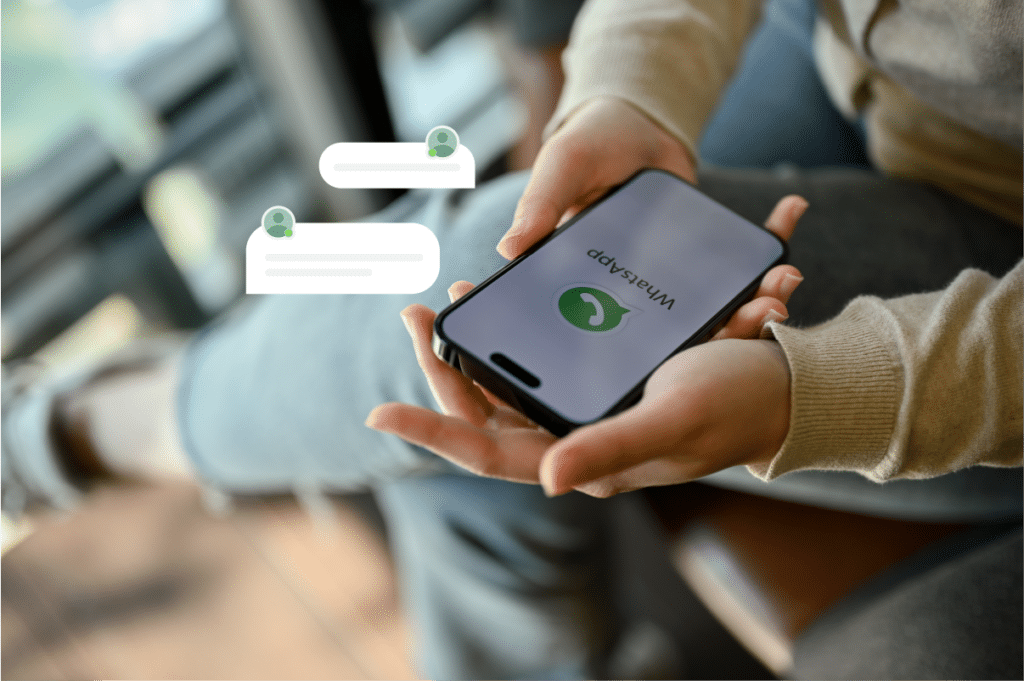
In the early days of messaging apps, consumers primarily used them to connect with family and friends. But today, consumers also rely on messaging apps to connect with brands.
In fact, for a staggering 66% of adults across the globe, messaging apps are the PREFERRED way of connecting with businesses. Younger consumers are even more fond of this communication channel; 72% say messaging apps are their preferred way of communicating with a business.
66% Of adults across the globe say messaging apps are their preferred way of connecting with a business.
Source: WhatsApp
The growing popularity of messaging apps as a means to communicate with businesses isn’t all that surprising. Modern consumers expect immediate engagement when they reach out to brands. Messaging apps provide those consumers with a convenient way to engage with a brand anywhere in the world – whenever and wherever a need arises. And they can make those connections without the cost and inconvenience of other communication methods – including phone calls and text messages.
Customer-centric brands must be equipped to provide winning experiences via consumers’ beloved messaging apps.
Read on as we discuss what messaging apps are – and explore some of the key apps global brands must have on their radar.
The 4-11 on Messaging Apps
Before we dive into the ins and outs of the most popular global messaging apps, let’s take a step back to align on what messaging apps are.
What are Messaging Apps?
Essentially, messaging apps are programs consumers download onto their computers or mobile devices that allow them to exchange messages. Messaging can be between two users – or it can be with a larger group. And messages can be some combination of text, video, and audio.
Unlike SMS, messaging apps rely on an internet connection, rather than phone reception. And, though it may seem obvious, a user can only message other users that have the messaging app.
What are the Use Cases for Messaging Apps?
Messaging apps are a key channel for consumers to stay connected with family members and friends.
But recent research tells us many consumers are already using (or open to using) these same apps to connect with brands.
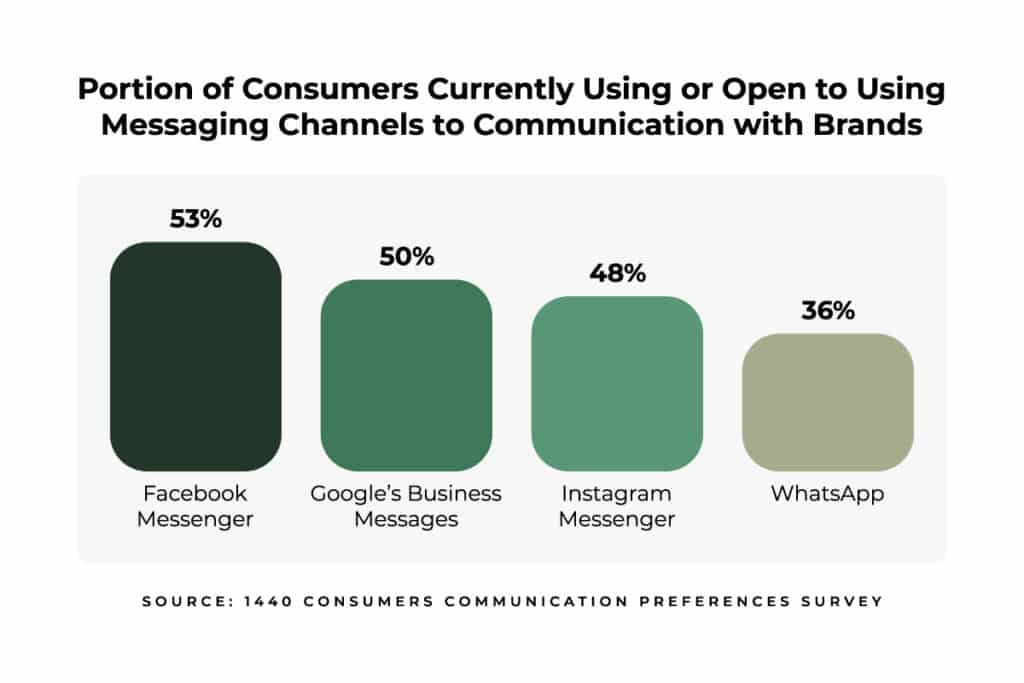
In fact, as we mentioned earlier, over half of consumers say that messaging is actually their preferred way of communicating with a brand.
How Popular Are Messaging Apps?
Messaging apps are hugely popular among consumers. In 2021, just over three billion people used messaging apps. By 2025, that number is expected to reach 3.51 billion.
There are a ton of messaging apps out there. Some are popular in a certain region – and barely used in other areas of the globe. And some have wide appeal throughout the entire world.
According to Statista, the three most popular global messaging apps with the highest number of monthly active users are:
- Facebook Messenger
We’ll explore these apps (as well as others) in more detail later on.
What Messaging Apps Should My Brand Be Using?
Engaging with consumers via messaging apps is a great way to make authentic connections that lead to sales and loyalty. But there are so many messaging apps out there. If your brand is just getting started with messaging, it can seem overwhelming.
A crawl-walk-run approach is the best.
First, determine which apps are used (and loved) most by your target market. The guide below can be a great starting point.
Then, choose a couple of key channels – and make a solid plan to support them. Adjust your strategy as needed, and add channels when (and if) it makes sense.
The Top Global Messaging Channels in 2023
Consumers are using messaging channels to connect with brands. If you’re not equipped to engage with consumers via these channels, you’re sure to lose business to a competitor that does.
Read on for a breakdown of some of the top messaging channels around the world.
#1 WhatsApp
In the world of messaging, there’s one app that leads the pack: WhatsApp.
According to Statista, WhatsApp is the most popular global messaging app, with two billion users across the globe. That means nearly a third of the worldwide population uses WhatsApp.
WhatsApp is used throughout the world. However, it’s particularly popular in certain markets. The five countries with the highest penetration rates are:
- Brazil: 98.9% penetration
- India: 97.1% penetration
- Italy: 97% penetration
- Argentina: 96% penetration
- Switzerland: 95.9% penetration
In addition, WhatsApp is particularly popular among women aged 55-64 and men aged 45-64.
If you’re a global brand, WhatsApp is a messaging app you can’t afford to ignore. By leveraging bots, you can provide instant answers to customers’ common questions and simple inquiries. This lightens the load on your support teams – while empowering you to meet your customers’ expectations. Your live team members are then freed up to spend their time on more complex matters.
#2 Messenger
Messenger – Facebook’s dedicated messaging app – is another key messaging channel brands can’t ignore. According to Statista, it’s the third most popular messaging app in the world.
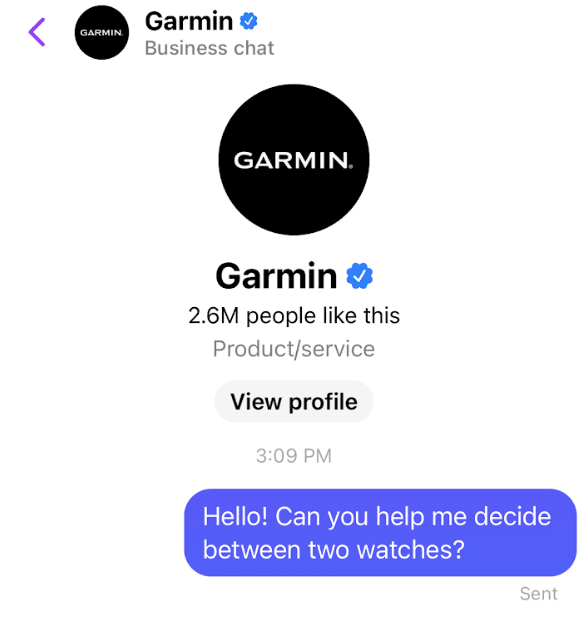
Messenger is popular throughout the world. However, it has a particularly high reach in North America.
In addition to using the app to send messages to family and friends, consumers also use it to connect with brands.
In 2019, people and businesses exchanged over 20 billion messages on Messenger each month – a number that has no doubt increased. In addition, recent research from 1440 found that over half (53%) of consumers are currently using or open to using Facebook Messenger as a way to communicate with brands.
53% Of consumers are currently using or open to using Facebook Messenger as a way to communicate with brands.
1440 Consumer Communication Preferences Survey
Facebook Messenger can be an effective way to connect with shoppers throughout the purchase journey. For example, brands can leverage chatbots to provide instant answers to common questions – 24/7. In addition, Facebook offers paid features such as click-to-chat and messenger ads that allow brands to engage in conversation with consumers – and accelerate their journey through the funnel.
#3 Google Business Messages
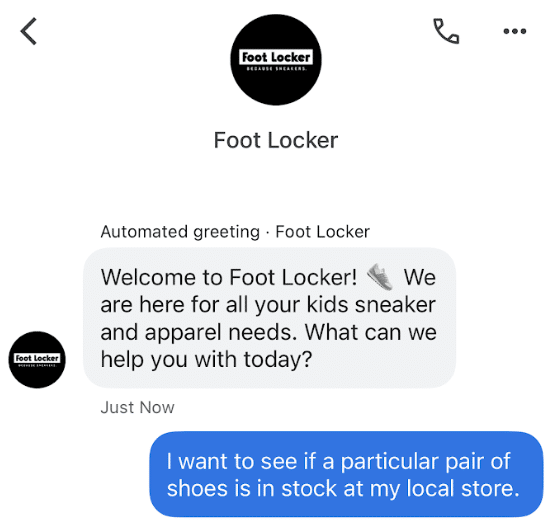
In many cases, a consumer’s search for a product or service starts on a search engine. And for many consumers, their search engine of choice is Google. Per Statista, Google accounted for more than 85% of desktop searches.
Google Business Messages enables brands to interact with consumers right within Google search and maps. And increasingly, consumers are using it to get help in their moment of need. Per recent research, 50% of consumers are currently using or open to using Google Business Messages to communicate with brands.
50% Of Consumers are currently using or open to using Google Business Messages as a way to communicate with brands.
1440 Consumer Communication Preferences Survey
Let’s say a consumer is shopping online for athletic shoes, and they need them quickly. They find a pair they like. Next, they run a search to find the location of their nearest shoe store. A chat icon appears in the search results, which allows the consumer to initiate a conversation with the brand. The brand verifies that the local store has the shoes in the shopper’s size. The consumer is able to pay for the shoes via the chat – and then they swing by the store, later on, to pick up their purchase.
#4 Instagram Direct
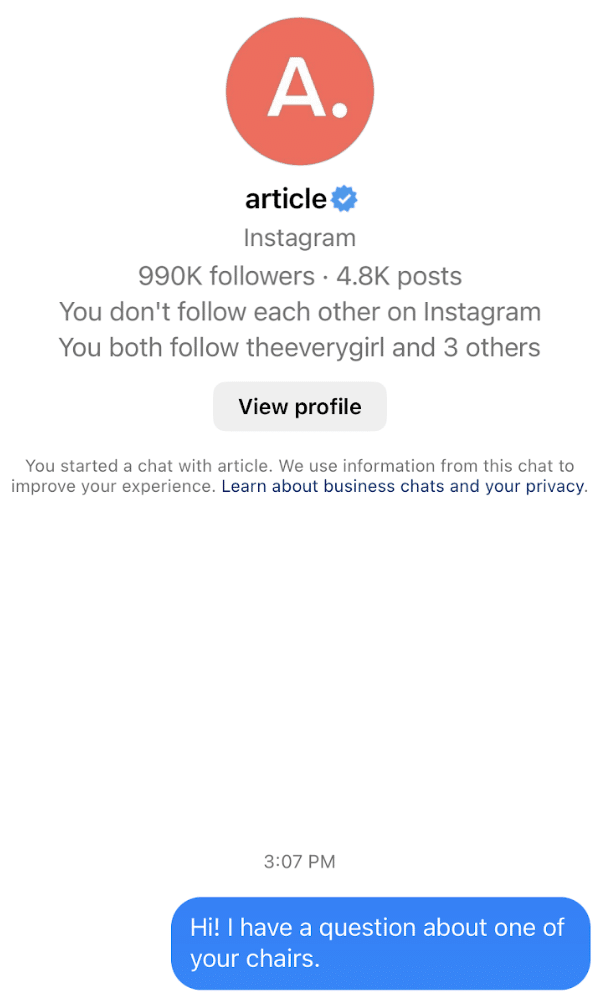
Instagram – the photo and video-sharing platform – is one of the most popular social networks out there. Per Statista, the platform has 2 billion monthly active users.
In addition to browsing photos and videos, users can also exchange direct messages (also known as DMs). This is becoming a popular way for consumers to engage with brands. Per 1440 research, nearly half (48%) of shoppers are currently using or open to using Instagram messaging to communicate with brands.
48% Of consumers are currently using or open to using Instagram messaging as a way to communicate with brands.
1440 Consumer Communication Preferences Survey
Instagram offers Instagram Direct, which is an in-app messaging product that allows brands to exchange messages with Instagram users – wherever they are on the purchase journey. Messages can include myriad components, including:
- Text
- Photos
- Posts
- Stories
Delivering great messaging experiences through Instagram Direct empowers brands to strengthen relationships and drive sales.
#5 TikTok Direct Messaging
TikTok is a hugely popular social media channel. Per eMarketer, the platform is expected to reach more than 834 million monthly users worldwide this year.
It’s especially popular among young consumers. In fact, there are more Gen Z consumers on TikTok than there are on Instagram.
Increasingly, consumers are using TikTok Direct Messaging to connect to businesses throughout the purchase journey. Per TikTok’s own data, about 20% of users have sent a direct message to a brand through the platform after making a purchase.
Gen Z’ers are particularly avid DM’ers. TikTok data also tells us Gen Z users are 1.2 times more likely than any other users to send a DM to a brand after making a purchase.
If Gen Z is a key target for your brand, now’s the time to look into TikTok Direct Messaging.
#6 Line
Line is a messaging app that was initially launched in 2011. It was launched shortly after the Tohoku earthquake hit Japan as an alternative to the usual telecommunications network. Since then, it’s experienced explosive growth. Today, the app has 194 monthly active users across the globe.
Messaging is a key use case of Line. However, the app is very robust and allows users to do various other activities – from streaming music to scheduling appointments to investing.
Line is extremely popular in Japan; 70% of those in the country use the app. What’s more, of the app’s 194 global monthly active users, 93 million are in Japan.
It’s also quickly gaining popularity in other Asian countries including:
- Taiwan
- Thailand
- Indonesia
This app will only continue to grow. So if you do business in Japan or in other countries where Line is popular, consider incorporating it into your conversational commerce strategy.
#7 Snapchat
Consumers use Snapchat to exchange “snaps” – which are photos or videos – with other Snapchat users. The app launched in 2011. And today, it’s still one of the top messaging platforms in the world.
Snapchat can be a key tool for brands looking to connect with consumers – especially younger ones. However, Snapchat is primarily used by brands for marketing; the platform doesn’t offer messaging for businesses.
#8 WeChat
According to Statista, WeChat is the #2 global messaging app in terms of active users. As of January 2023, the app has more than 1.3 billion monthly active users.
WeChat is an example of an app that is hugely popular in a specific region – but not so much in others. The app is very popular in China. In fact, one billion of WeChat’s users live in China.
Of course, consumers can use the app – sometimes referred to as China’s WhatsApp – to send messages. But they can also use it for other business-related use cases – including making payments and booking hotels and flights.
If you’re a brand that does a lot of business in China, WeChat is a messaging app that must be on your radar.
#9 Viber
Viber is another popular messaging app that allows users to exchange text, video, or audio messages with other users. Some Viber users also use the platform to make payments.
Each hour, there are 70 million interactions on Viber. And the app is growing in popularity – with users in more than 190 countries.
Viber is a popular platform in Europe. The countries where Viber is particularly popular include:
- Bulgaria
- Greece
- Ukraine
Interestingly, about 98% of the population of Ukraine are Viber users.
Brands can connect with consumers on Viber by using ads, stickers, and messaging. They can also integrate chatbots to ensure users can get support any time of day.
#10 Telegram
Telegram is a cloud-based instant messaging service – with functionality that’s similar to Messenger. According to Statista, the app has 700 million monthly active users – making it the #4 most popular messaging app in the world.
The company is currently headquartered in Dubai. And the platform is particularly popular in certain regions of the world. According to SimilarWeb via ChartsBin, Telegram is the most popular messaging app in Iran and Uzbekistan.
#11 QQ
QQ is another example of a messaging app used primarily in China. According to Statista, QQ has 574 million monthly active users – making it the #6 messaging app in the world. It’s particularly popular among young consumers.
It’s important to note that QQ is owned by Tencent – which is the same parent company as WeChat.
#12 X (Formerly Known as Twitter)
Twitter was founded in 2006 as a way to send and read short posts – called tweets. Users can also exchange private, direct messages (DMs).
As of this year, the platform has about 450 monthly active users. The United States is the country with the most Twitter users.
Last year, Elon Musk purchased Twitter. And ever since, the company has been making headlines.
Recently, the app was rebranded as “X.” In addition, the company has made changes to the way users direct message each other. Notably, “unverified” users have a limit on the number of DMs they can send. Users can get this limit lifted by paying a monthly subscription fee.
X is currently undergoing a lot of changes. Brands must keep a pulse on these changes – and determine if this is a platform that makes sense for connecting with their customers.
#13 Threads
Threads is a new social media app built by the Instagram team. And it’s one you’ll definitely want to keep an eye on.
According to Meta, their vision for Threads is to “take what Instagram does best and expand that to text, creating a positive and creative space to express your ideas.”
Threads allow users to make posts up to 500 characters long, which can include:
- Links
- Photos
- Videos up to 5 minutes long
Other users can engage with those posts by replying to them.
It’s still the early days for Threads. But there may be opportunities for your brand to tap into this platform to engage with your target markets.
#14 Apple Messages for Business (Formerly Apple Business Chat)
Apple Business Chat entered the scene in 2018, and it has since been rebranded as Apple Messages for Business.
Apple Messages for Business is a platform that allows brands to connect with customers via their Apple devices – including iPhone, Mac, Apple Watch and iPad. In addition to exchanging messages with businesses, consumers can also use Apple Business Chat to complete other tasks, including:
- Scheduling appointments
- Making purchases
- Exchanging information
Today, Apple owns more than 30% of the global smartphone market share. That’s not to mention the millions of consumers who own other Apple devices. If your target market uses Apple devices, Apple Messages for Business is a channel that should be on your radar.
It’s Time to Embrace Messaging Channels
Increasingly, messaging channels are the way consumers want to interact with brands throughout the purchase journey. Brands must embrace the channels that matter most to their shoppers.
But there are a ton of messaging channels throughout the globe. It can be challenging to effectively manage them – on top of other support channels.
If you’re a brand that uses Salesforce, it’s time to start managing messaging channels right within the platform.
Messaging Studio from 1440 empowers brands to engage with shoppers through their beloved messaging channels – all within Salesforce. And with Translation Studio, you can deliver messaging experiences in your customers’ native languages.
Ready to see our solutions in action? Contact us to schedule a live demo.